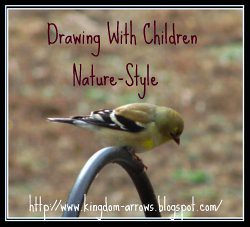So now that you
know us Olive Plants a little better, it's time to get to know your parts better...your birding parts, that is!
Our first birding outing was hysterical.
At least thinking back on it is hysterical. At the time, it was exhausting and frustrating.
I loaded down the boys, ages 5 and 6 at the time, with all the "necessary" gear. Each carried his own binoculars, a field guide, the Les Beletsky
Bird Songs book, an Identiflyer and a backpack containing a journal, colored pencils, snacks and water. We were ready to do some serious bird watching!
As you can imagine, within minutes they were hot and tired and couldn't find many birds. When they did see a bird, by the time they could get the binoculars to their eyes and start to focus, it had flown away. Or if they got a good view of the bird, they would forget what it looked like as they flipped through the field guide. And trying to scroll through all those bird calls and songs in the Beletsky book was FRUSTRATING!
I wondered if they were too young or if birding wasn't something they really wanted to do. However, within a few weeks we went back to the same spot, and they were fully engaged and loving every minute of bird watching. What made the difference? I think it was a change I made in our approach.
Instead of jumping in feet first, we took some time to build our knowledge. We began by learning the parts of a bird.
The resource we found most helpful was Jeannie Fulbright's Flying Creatures of the Fifth Day (Apologia). This is a great science course for the elementary years and gave my boys the basic knowledge I was seeking for them. She writes in a way that kids can easily understand but does not water-down the content. Soon we were able to discuss birds in a very specific way.
This bird has a yellow rump.
This bird has black and white wing bars.
This bird has a curved beak.
Having a well-developed birding vocabulary helped my boys to quickly recognize and retain what they would see while bird watching and be able to communicate that information to other members of their bird watching team. You may not be preparing to bird competitively, but it is still fun to bird watch as a group and important to be able to tell your birding friends what you have seen. This knowledge also helps birders navigate their field guides much more quickly (but more on that another day!).
We also completed Notebooking Page's
Nature Study- Birds, the complete set. These pages allowed us to create our own "field guide".
I selected 3-5 birds per week for us to study. We read about the birds of the week in our real field guides and examined each bird's shape, size, color, bill shape and size, silhouette, and field marks very closely. Then the boys completed the notebooking page for each bird, paying particular attention to coloring with detail. Of course, young children are not going to color with complete accuracy but I encouraged them to make their picture as realistic as possible and praised them for including details like eye stripes or wing bars, even if they weren't spot on.
 |
The Notebooking pages
allow children to color accurate representations
of the birds to be learned
and to learn important birding skills
such as reading a range map. |
Once the pages for the week were completed, we kept our eyes peeled for those birds. I set up feeders close to our school room windows so we could easily watch for them to show up throughout the day. We went for a daily walk around our neighborhood where there are a lot of houses with multiple feeders. We visited a local birding hot spot at least once per week. I made sure the first 20-something birds they learned were very common birds which they would be sure to see regularly. Success came quickly and enthusiasm grew!
During this stage of learning, when we did venture out into the field, I carried the only pair of binoculars and one field guide. We did not try to journal or take pictures. We only identified what we had studied. I wasn't trying to stifle their curiosity but build interest while alleviating frustration. Within a few weeks, they were ready to discover more. They were noticing birds besides the common ones they knew and were eager to identify them, too.
That's when we took the next step and I taught them how to use their very own binoculars. I will tweet more about that next time!
Until we tweet again...
Dawn,
for the Olive Plants
Disclosure:
I am an affliliate for amazon.com and notebookingpages.com. If you make a purchase from either site after following the links provided in this post, I will receive a commission. I have not been otherwise compensated for writing this post and have provided my honest evaluation of each product.





































